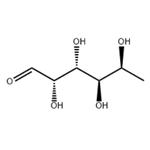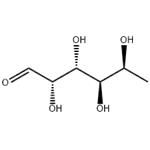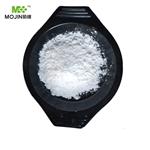- L-Fucose
-

- $0.00 / 1kg
-
2024-04-07
- CAS:2438-80-4
- Min. Order: 0.10000000149011612kg
- Purity: 99%
- Supply Ability: 2000kgs
- L-Fucose
-

- $0.00 / 1KG
-
2024-02-06
- CAS:2438-80-4
- Min. Order: 1KG
- Purity: 98%
- Supply Ability: 500KG per month
- L-FUCOSE
-

- $100.00 / 1KG
-
2023-09-05
- CAS:2438-80-4
- Min. Order: 1KG
- Purity: 99%
- Supply Ability: 5000KG
|
| | L-Fucose Basic information |
| | L-Fucose Chemical Properties |
| Melting point | 150-153 °C(lit.) | | Boiling point | 211.61°C (rough estimate) | | alpha | -73~-77°(D/20℃)(c=4,H2O,24hr) | | density | 1.1738 (rough estimate) | | refractive index | -75.5 ° (C=10, H2O) | | storage temp. | Inert atmosphere,Store in freezer, under -20°C | | solubility | H2O: 0.1 g/mL, clear, colorless | | pka | 12.50±0.20(Predicted) | | form | Powder | | color | Beige to light brown to purple-grayish | | Water Solubility | Soluble in water. | | Sensitive | Hygroscopic | | Merck | 14,4279 | | BRN | 1723321 | | Stability: | Stable. Incompatible with strong oxidizing agents. | | InChIKey | SHZGCJCMOBCMKK-DLABPRKASA-N | | LogP | -0.340 (est) | | CAS DataBase Reference | 2438-80-4(CAS DataBase Reference) | | EPA Substance Registry System | L-Galactose, 6-deoxy- (2438-80-4) |
| Safety Statements | 24/25 | | WGK Germany | 3 | | F | 3-10 | | TSCA | Yes | | HS Code | 29400090 |
| | L-Fucose Usage And Synthesis |
| Description | L-(−)-Fucose is a deoxyhexose monosaccharide found on N- and O-linked glycans and glycolipids of a wide variety of organisms. It can exist as a terminal modification of glycan structures or serve as a point of attachment for adding other sugars. In humans, L-(−)-fucose plays a role in A and B blood group antigen substructure determination, selectin-mediated leukocyte-endothelial adhesion, and host-microbe interactions. | | Chemical Properties | White crystalline powder, soluble in methanol, ethanol, DMSO and other organic solvents. | | Chemical Properties | l-fucose is a six-carbon sugar also known as 6-deoxy-l-galactose. Its molecular formula is C6H12O5 and its melting point is 150.0–153.0 °C. It is a white crystalline powder that easily absorbs moisture, and its hydrophilicity is weaker than that of other monosaccharides. l-fucose is the main form of fucose found in nature and is also the only levorotatory sugar used by mammals, while d-fucose is found only in some glycosides[1]. | | Occurrence | L-Fucose exists in nature in various biological niches. A major natural source of L-fucose is the brown algal polysaccharide fucoidan. It is also present in the polysaccharides of tragacanth, potatoes, kiwi, soybeans, varieties of wing peas, canola and other plants.L-Fucose is a minor component in plant cell wall polysaccharides, specifically rhamnogalacturonan, xyloglucan and also arabinogalactan proteins that are involved in plant cell elongation. | | Uses | L-Fucose was isolated from seaweed. It finds application in cosmetics, pharmaceuticals and dietary supplements. It is used in the determination of antigen in A and B blood group. It is also used in the selection-mediated leukocyte-endothelial adhesion and host-microbe interactions. L-Fucose is also used in anti aging creams as well as to promote the accelerated healing of wounds and to reduce allergy. | | Definition | ChEBI: L-fucopyranose is the pyranose form of L-fucose. It has a role as an Escherichia coli metabolite and a mouse metabolite. It is a L-fucose and a fucopyranose. | | Reactions | L-Fucose is oxidised by the enzyme L-fucose dehydrogenase in the presence of nicotinamide-adenine dinucleotide phosphate (NADP+) to L-fucono-1,5-lactone with the formation of reduced nicotinamideadenine dinucleotide phosphate (NADPH) (1).
(L-fucose dehydrogenase) (1)
L-Fucose + NADP+ --> L-fucono-1,5-lactone + NADPH + H+
The amount of NADPH formed in this reaction is stoichiometric with the amount of L-fucose. It is the NADPH which is measured by the increase in absorbance at 340 nm. | | Biological Functions | l-fucose has many biological functions like the antitumor effect and relieving intestinal disease, and exhibits potential as an emulsifier in the food industry. It can be used as a functional food and one of the components of bacteriostatic agents. Moreover, it also has an anti-aging function[1]. | | Biological Activity | L-Fucose (6-Deoxy-L-galactose) is used in studies of fucoidan polysaccharides containing glycans. It is studied as a glycan modifying carbohydrate that generates antigenic sites recognized by IgE antibodies. It is used as a substrate to identify, differentiate, and characterize enzymes such as fucosidase(s),l-fucose isomerase(s), and L-fucose dehydrogenase(s). It may be used to study organelles, and bacterial microcompartments, involved in the degradation of plant and algal cell wall sugars. L-Fucose may also be used as a reference compound in rare sugar identification and analysis. | | References | [1] Yan Wang . “Research progress on the functions, preparation and detection methods of l-fucose.” Food Chemistry 433 (2023): Article 137393. |
| | L-Fucose Preparation Products And Raw materials |
|